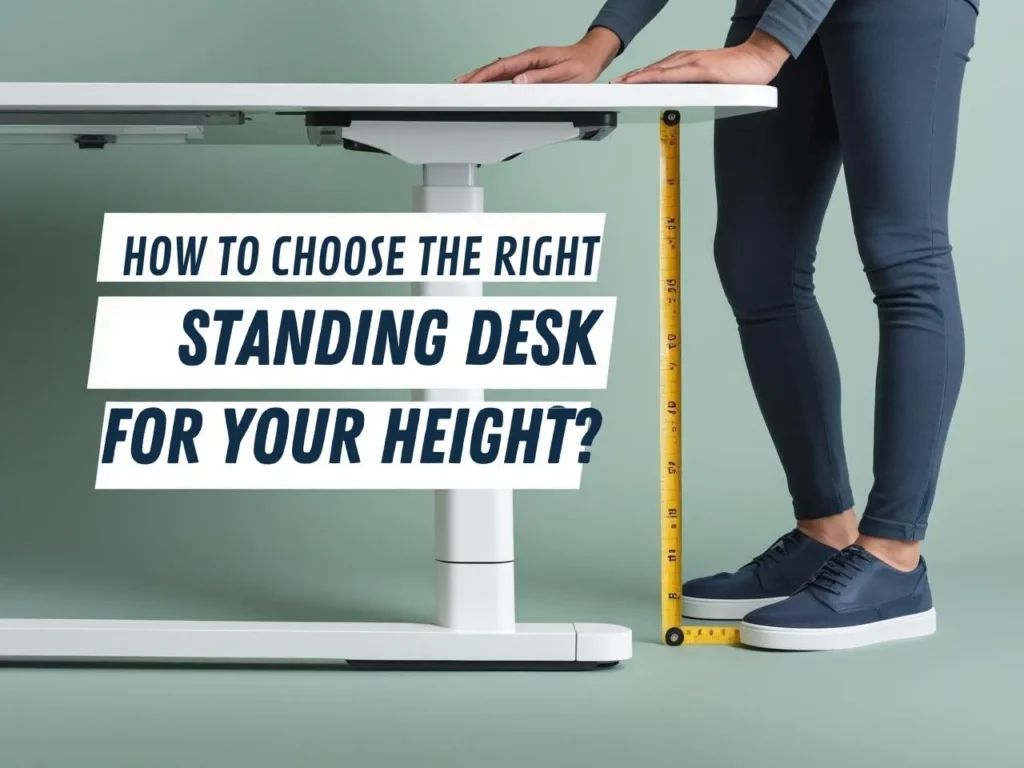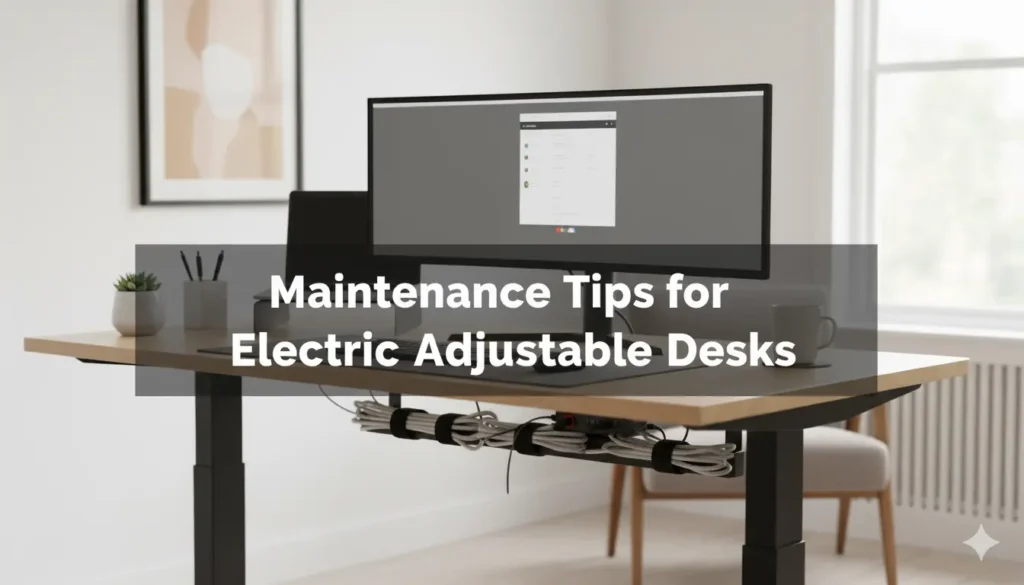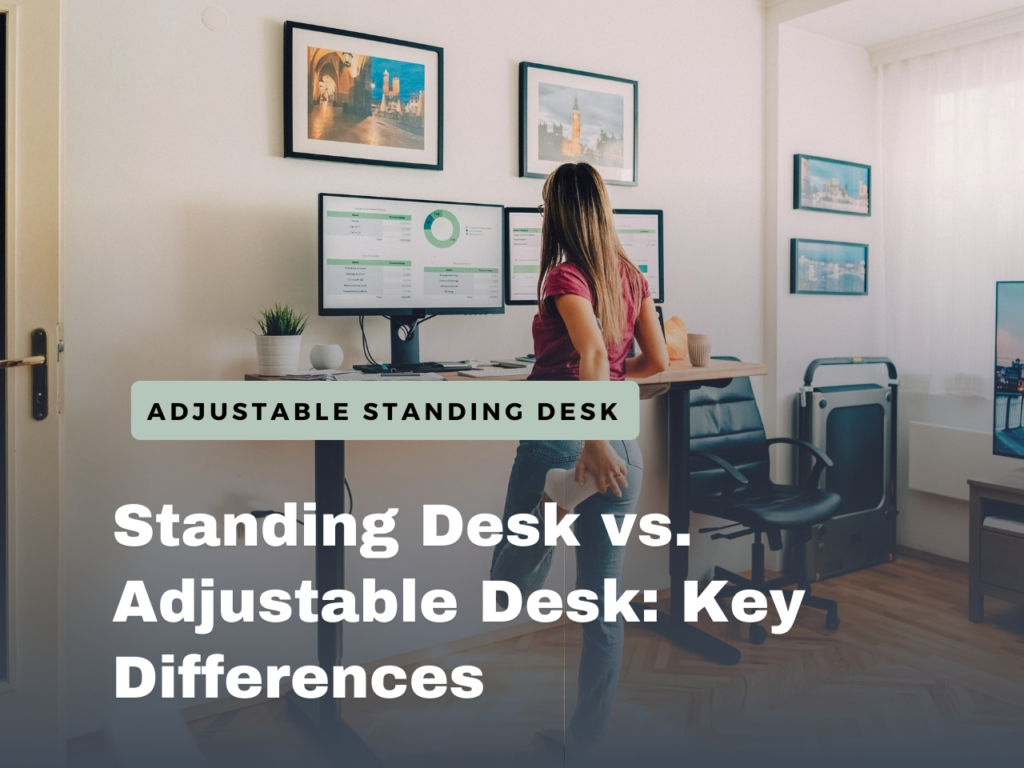Last month, my neighbor Sarah knocked on my door looking absolutely defeated. She’d just spent $400 on a “premium” standing desk that was supposed to transform her work-from-home experience. Instead, three weeks in, her back hurt worse than ever, and she was convinced standing desks were just expensive hype.
The problem wasn’t the desk itself – it was completely wrong for her 5’3″ frame. The manufacturer’s “one-size-fits-all” height recommendations had her hunching over like she was peering into a microscope all day.
This happens way more than you’d think. People get excited about the health benefits of standing (which are real!), drop serious money on equipment, then give up because nobody taught them how to find the right height for a standing desk. It’s honestly heartbreaking because a properly fitted standing workspace can genuinely change how you feel during long work sessions.
I should know – I’ve been tweaking my setup for almost three years now, and I’ve helped a dozen friends avoid Sarah’s mistake. Today I’m going to walk you through everything I wish someone had told me before I bought my first converter standing desk.
Are Standing Desks Good for You?
Here’s what nobody talks about in those glossy marketing emails: standing desks aren’t magic. They won’t instantly cure your back pain or turn you into a productivity superhuman. But when you use them right? They’re pretty incredible.
My own story started during the pandemic. Like everyone else, I was suddenly working from my kitchen table eight hours a day. By week three, my lower back felt like I’d been carrying a backpack full of rocks. A friend who works in physical therapy mentioned that alternating between sitting and standing might help.
I was skeptical. Standing all day sounded exhausting and kind of pretentious, honestly. But the research kept popping up everywhere – reduced back pain, better posture, more energy. Stanford even found that people walking and standing had 60% more creative output than those who stayed seated.
The real revelation came when I borrowed a friend’s adjustable desk for a week. Not the standing part – that took some getting used to – but the ability to change positions when my body needed it. During intense design work, I’d sit and focus. For calls or brainstorming, I’d stand and pace a little. My afternoon energy crashes practically disappeared.
The key insight? Your body craves variety. Sitting isn’t evil, and standing isn’t virtuous. They’re just different positions that serve different purposes throughout your day.
Is Standing Desk Better Than Sitting?

This question always makes me laugh because it’s like asking whether running shoes are better than dress shoes. Depends what you’re doing, right?
I sit when I’m deep in complex UX flows or editing detailed mockups. There’s something about the stability that helps me focus on precise work. But I stand for client presentations, team meetings, and when I’m reviewing designs and need that broader perspective.
What changed everything was realizing I didn’t have to pick a side. My converter standing desk lets me switch based on what I’m doing and how my body feels. Some days I’m 70% standing, other days barely 20%. Both are fine.
The research backs this up too. A study from Texas A&M found that workers with sit-stand desks were 46% more productive than those stuck in chairs all day. But the magic wasn’t in constant standing – it was in having options.
Dr. Alan Hedge from Cornell puts it perfectly: “The goal is not to stand all day, but to break up prolonged sitting with movement and position changes.” Your body wasn’t designed to hold any single position for hours at a time.
Here’s what I’ve noticed after two years of switching back and forth:
- Morning meetings feel more energetic when I’m standing
- Detailed work flows better when I’m seated
- I naturally want to move more throughout the day
- That 3 PM slump hits way less often
What is the Right Height for Standing Desk?
Okay, this is where most people (including past me) mess up completely. There’s no universal “perfect” height because we’re all built differently. But there are some reliable ways to figure out what works for your body.
The basic rule everyone quotes is the 90-degree elbow angle. Stand naturally, let your arms hang loose, then bend your elbows 90 degrees. That’s roughly where your desk surface should be. Sounds simple, except most people forget about keyboards, monitors, and shoes.
Here’s what I learned the hard way: measure everything in your actual work setup. When I first calculated my “perfect” height, I only considered typing position. Then I added my monitor stand and suddenly I was craning my neck up all day like I was watching airplanes.
Real talk? It took me about six weeks of small adjustments to dial in my ideal setup. I started with the elbow measurement, then tweaked based on how my body felt after a few hours of work. Some days my ideal height feels different depending on my energy level, what I’m wearing, or even how much coffee I’ve had.
For reference, I’m 5’6″ and my sweet spot landed at 43 inches for the desk surface. My shorter friends usually end up around 39-41 inches, while my tall coworkers need 47-50+ inches. But these are just starting points – your body will tell you what adjustments to make.
Getting Your Measurements Right
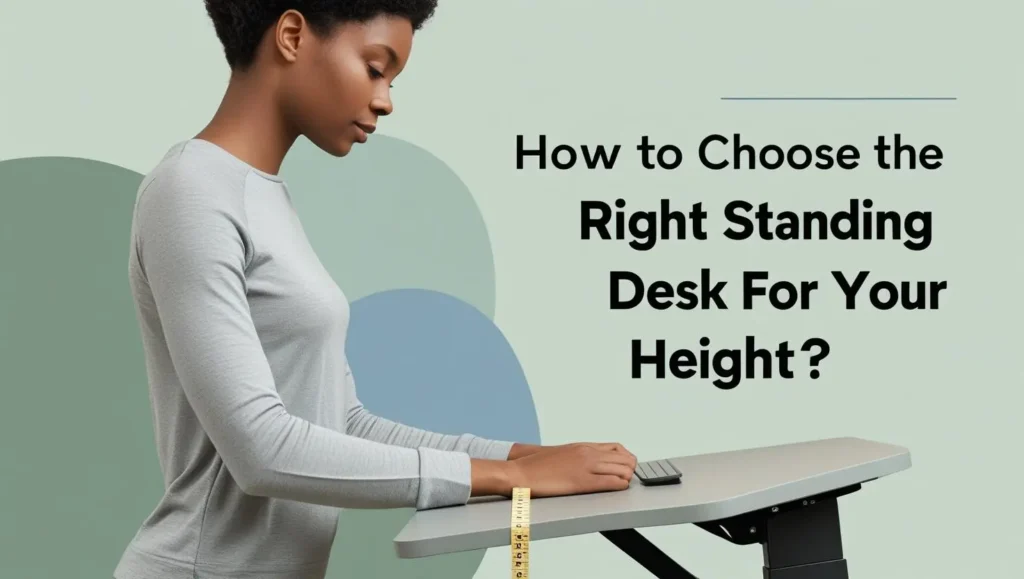
This part is crucial, and honestly, most people rush through it. Take 10 minutes to do this properly and you’ll save yourself weeks of discomfort.
Step 1: Measure barefoot first Stand against a wall, arms relaxed, then bend your elbows 90 degrees. Have someone measure from the floor to the bottom of your elbow. Write this number down.
Step 2: Add your typical footwear If you usually work in sneakers, measure with sneakers on. Slippers? Measure in slippers. This can shift your height by 1-3 inches, which matters more than you’d think.
Step 3: Account for your keyboard Using a laptop directly on the desk? You might need to lower the surface by an inch or two. External keyboard? The thickness adds height, so your desk can be a bit lower.
Step 4: Check your monitor situation Measure your screen setup. The top of your monitor should be at or slightly below eye level when you look straight ahead. If your calculated desk height makes you look up or down awkwardly, something needs adjusting.
This seems like overkill, but I promise it’s worth it. My friend Mike skipped the measuring and spent three months with chronic neck pain before he realized his monitor was way too high.
Why Adjustable Range Matters More Than Perfect Height
Here’s something that surprised me: the range of adjustment on your desk is often more important than hitting some theoretical perfect measurement. Bodies change throughout the day. Some mornings I feel like standing taller, other afternoons I want to slouch a bit.
Most people need at least 10-12 inches of adjustment range to cover both comfortable sitting and standing heights. I always recommend going bigger if your budget allows – having that extra flexibility means you can fine-tune as you figure out what works.
My current setup adjusts from 28 inches (perfect sitting height) to 48 inches (standing). That 20-inch range lets me accommodate different shoes, tasks, and moods without fighting the equipment.
Pay attention to how smooth the adjustment mechanism is too. If it’s a pain to change heights, you won’t do it regularly, and the whole system falls apart. I’ve tried manual cranks, pneumatic, and electric motors. Pneumatic hits the sweet spot for most people – smooth, quiet, and reliable.
Setting Up Everything Else
Getting the desk height right is only half the battle. The other pieces of your setup can make or break the whole experience.
Monitor positioning killed me initially. I had the desk height perfect, but my laptop screen was way too low. I ended up looking down all day and developed what my chiropractor cheerfully called “tech neck.” Now I use a laptop stand to get the screen up to eye level, with a separate keyboard and mouse.
Anti-fatigue mats aren’t just marketing fluff. I was stubborn about this for months, standing directly on hardwood floors. Bad idea. A decent mat reduces leg fatigue significantly and makes longer standing sessions actually enjoyable.
Start gradually or you’ll hate it. I made the mistake of trying to stand for six hours on day one. My feet were screaming, my legs were shaky, and I was ready to give up entirely. Now I tell everyone to start with 30-minute chunks and build up slowly.
The sweet spot I’ve found is alternating every 45-90 minutes, depending on what I’m working on. Long enough to get the benefits, not so long that I get uncomfortable.
Common Mistakes That Kill Your Setup
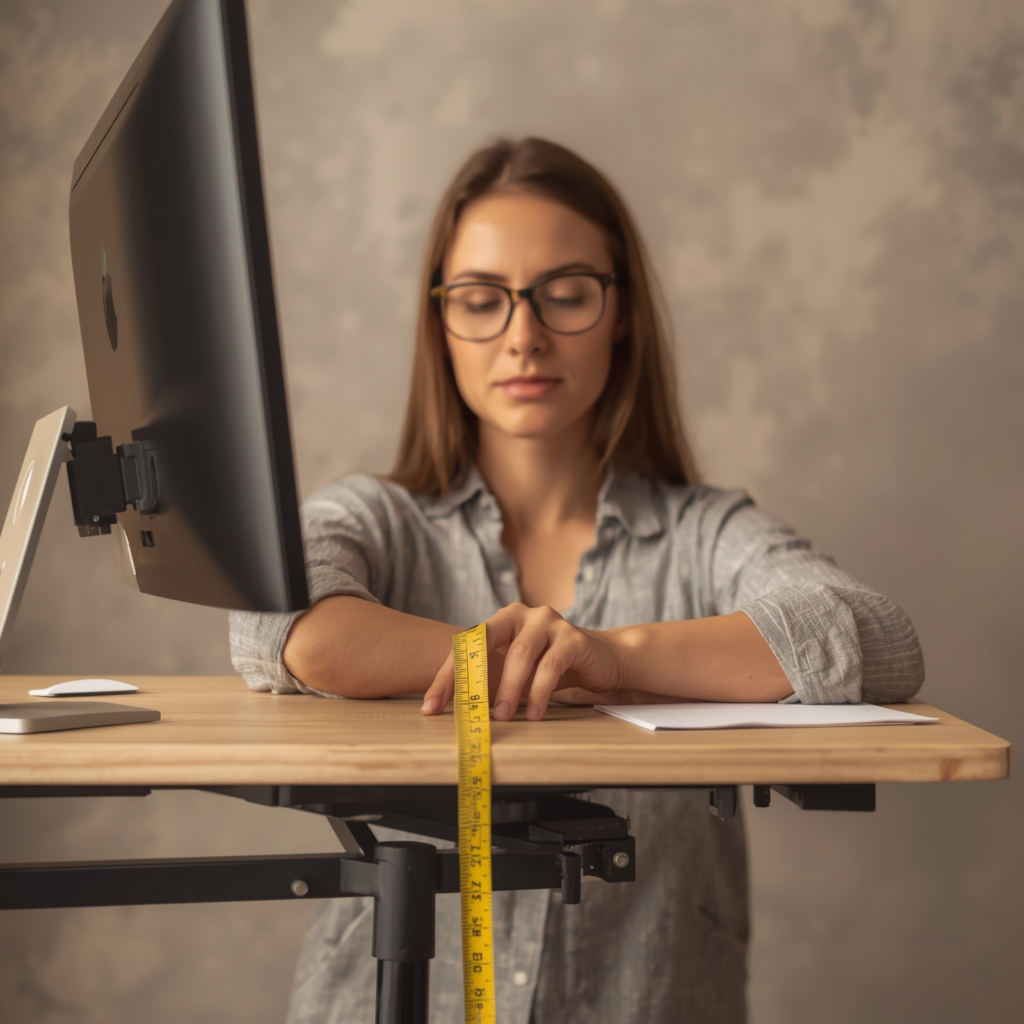
After helping friends set up their workspaces, I’ve seen the same mistakes over and over again.
Copying someone else’s measurements is probably the biggest one. My coworker Dave is 6’2″ and kept insisting I should use his desk settings because they worked great for him. I’m seven inches shorter. It was a disaster.
Ignoring your actual work habits is another big one. If you spend most of your day on video calls, optimize for that. If you’re doing detailed design work, prioritize comfort for precise tasks. Don’t set up for some theoretical ideal workday that doesn’t match reality.
Buying the cheapest option usually backfires. I get it – good adjustable desks are expensive. But a wobbly, difficult-to-adjust desk that you never want to use is money wasted. Better to save up for something solid or start with a quality converter standing desk that works with your existing setup.
Not measuring your complete setup trips up almost everyone. The desk height that works with your laptop directly on the surface is completely different from what works with a monitor arm and external keyboard.
Making It Work Long-Term
The honeymoon period with a new standing desk lasts about two weeks. Then reality sets in – your feet hurt, you’re not sure when to sit vs. stand, and you start to wonder if you wasted your money.
This is totally normal. It took me about a month to stop thinking about the mechanics and just naturally switch positions based on what felt right. Now it’s as automatic as adjusting the thermostat.
The real magic happens when you stop following rigid rules and start listening to your body. Some days I barely stand at all if I’m deep in complex work. Other days I’m up 60% of the time. Both approaches work fine.
What matters is having the option to change positions when you need to. That flexibility – not standing itself – is what transformed how I feel during long workdays.
If you’re considering making the switch, start with your measurements, invest in quality equipment that adjusts smoothly, and be patient with the transition. Your back will thank you, even if it takes a few weeks to get everything dialed in just right.

